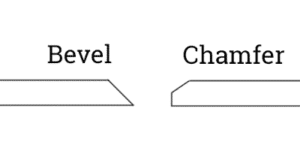
Nevertheless, knowing the difference between the two finishes is essential, especially in fabricating custom products requiring stainless steel, nickel alloys, aluminum, or titanium. Manufacturers of components and parts for medical, electronic, tooling, construction, semiconductor, industrial, and aerospace applications may require ultra-high precision cut beveled or chamfered edged pieces for varying applications.
Difference Between Bevel and Chamfer
In comparing the two, remember that each refers to an edge that is not perpendicular to the face of the workpiece. That said, the distinction between a beveled edge and a chamfered edge lies in the angle and length of the cut. A bevel is an edge that slopes along the edge of a surface, while a chamfer is a transitional edge, made at a 45° angle, which connects two surfaces.
Bevel Applications
Bevel cuts, such as in cabinet trim, picture frames, and moldings, can be decorative. The application for bevel cuts is not just for aesthetic purposes but is often utilized for safety, wear resistance, or to facilitate the joining of one piece with another. Bevel cuts are necessary to fit moldings at angles and are a common joinery technique. Beveled edges can even be found on many cutting tools. Mirrors and glass top tables often have bevel-cut edges for protection from cuts. The sharpened angular tip at the end of a medical needle is beveled for use in types of skin injections. The correct needlepoint geometry for intramuscular and subcutaneous injections depends on the bevel angle at the tip.
Chamfer Applications
Though the chamfered edge is often described as a form of or type of bevel, the 45° angle of the chamfer cut distinguishes it from a bevel edge. The cut of a chamfered edge does not extend from one end of the piece to the other, making the workpiece’s shape slightly different. The chamfer edge can be formed on the inside or outside of the adjacent faces of an object. They can be employed to ease an otherwise sharp edge for safety or to prevent damage.
Frequently used in finish work of metals, wood, and other materials, the edge is commonly utilized in mechanical and manufacturing engineering. It is a common edge design in machining, printed circuit board designs, medical devices, furniture such as counters and table tops, poured-in-place concrete formwork, and mirrors.
Though often a source of confusion, a bevel vs. chamfer edge can mean a big difference in the finish requirements of a workpiece. Remember that the chamfered edge is designed at a 45° angle. If the edge doesn’t conform to that angle, it is beveled.
Contact the Experts at Atlantic Stainless
Atlantic Stainless is proud to be a trusted distributor of the highest quality stainless steel; we are truly a “one-stop” service center. With a combined experience of over 150 years, our experienced sales team is available to answer any questions on stainless steel or other products we supply.
If you have a project in mind, request a quote from Atlantic Stainless today!

